
There are a few things going on to make these carrot cupcakes delicious, most notably the addition of air.
The Author was teaching The Poppet how to play guitar. His instructions? “Just pick it up and play along with a song you like. That’s how you’ll learn.”
Well, I think I might have a thing to say about that. First of all, if you don’t know how to do something, how can you start doing it? Secondly, how do you get the confidence?
I was thinking about this because it’s similar to telling someone how to cook something. When you’ve done it for a while, it seems pretty easy. “Cook till done.” “Bake till the loaf sounds hollow.” But what does “hollow” mean with a loaf of bread?
Sometimes the recipes are not written down, so it’s a matter of judgement. At work I’ll tell people who are cooking with me, “Put a big glug of olive oil in the pan…” They might look at me quizzically. They are used to home-cooking sizes, I’m used to cooking for 50, 60, or more. So I’ll amend my directions to: “A bigger glug than you would think.”
None of this is scientific.
Yet cooking is a science, and it is also an art, and the more you do it, the better you get at it. Watching, listening, tasting, touching, smelling – these are all the actions of a cook. None of them are hard to do, but you need to know what you are watching, listening, tasting, touching and smelling for. I sometimes feel like I am getting away with something; by preparing meticulously and organising my meal plan, putting it together is stupidly simple. Anyone could do it. And really, anyone can. With practice. Like playing the guitar, I suppose.
Still, there are some basic things that will always help when you are trying to get a dish to come together. Here are my top ten tips for making a dish taste great, in no particular order:
1. Salt
Salt makes food taste good, plain and simple. It is the number one flavour enhancer, even making its way into sweets to round out and enhance the sweetness. Chances are, if your food in the pan is a little bit lacking, it might just need a pinch of salt.
There is a reason that humans (and other animals) crave salt. Physiologically, we need it. Whenever we sweat (which is all the time, really, but most noticeable in the summer) we lose body fluids and salt, and we need to replace that for a healthy, balanced system. Based on this, I guess summer is probably the best time to have a good, hot bowl of chicken soup!
And for the record, salt is not bad for you! If you are not eating a lot of processed food, you are probably okay with a little more salt. The NHS has this to say: “The salt we add during cooking and at the table makes up only a small amount of salt in our diets. Around 75% of the salt we eat comes from ready-made and processed foods, such as bread, breakfast cereals, soups and baked beans [my emphasis]. Even sweet things, such as biscuits, can have salt added to them.”
So if you are eating well (i.e. not eating a lot of processed food) you don’t really need to worry about the salt in your homemade food. My big tip for adding salt, however, is to take a tiny portion of your food-in-the-making (in a little cup, or even on a spoon) and add a wee bit of salt. If the salt makes that bite taste better, go ahead and add some more salt to the general pot. If it doesn’t, go the the next step…
2. Fat
Let’s just put it out there: fat is flavour. Or rather, fat carries the flavour around; it helps the flavour to stick to all your little tastebuds and linger there, so you can extract every morsel of deliciousness before it all goes down the hatch.
Fat could take the form of olive oil, coconut oil, chicken fat, butter, bacon grease… Options are limited only to your beliefs and preferences. My friend Tchenka wrote a recipe for lentil soup which is so simple and delicious, but when the soup is almost ready, if you taste it, you would probably think (as I do), “Eh. It’s not that great.” However, the final and crowning touch is to blend in a walloping amount of olive oil, and boy does that make the soup sing! All the flavours pull together and become so much more than the sum of their parts. Every time I make this soup at work, I get compliment after compliment, and no one can believe how simple and easy it is.
Also, adding fat to your food is important not just because it makes most food taste better, but because it increases satiety, which means that you will feel more full and satisfied. And that means that you will probably eat less in the long run, with fewer in-between meal cravings.
And if that isn’t enough to convince you, how about this: your brain is made up of 60% fat. It needs fat to thrive and to help it maintain important cell functions. Don’t be afraid of fat. It’s practically a miracle ingredient!
3. Booze
When I say booze, I don’t mean just for the chef, but for the food as well! A hit of wine, for example, enhances flavour by giving food a bit of acidity. Alcohol also adds its own key flavour to dishes, many of which are based on it (Coq au Vin springs to mind). Wine almost always should be added near the beginning of cooking; as much as I love a glass of Chianti, I’m not that keen on having it hot with some herbs and tomatoes in it. Wine needs to cook into the dish, so it becomes a part of the dish, so be sure to add it (or any alcohol) at the start, most often after sautéeing the vegetables. You can see a recipe using this process here.
But even though I say booze, I also mean acid – lemon juice and vinegar figure highly in my repertoire for finishing a dish. A Caesar Salad would be stodgy and bland without both of them, and many a bean soup has been saved with the addition of some red wine vinegar.
Once again, I would suggest taking a portion of the dish you want to adjust, and trying a little vinegar or lemon juice in it. If that doesn’t work, there’s always …
4. Water
Sometimes a dish just needs to be loosened. A creamy pasta dish, for example, can quickly lose all its creaminess, becoming glue-like and extremely unappealing. The trick is not to add more cream, which will make it heavier, stodgier and overwhelming, but to add a little bit of water to bring the cream back to its creamy state.
Water also works if you are making a pureed vegetable or bean soup and you can’t get it creamy. Sometimes the discrete pieces just need some water to blend into. This really works, and I often get people asking me if there’s cream in the soup, even when the soup is vegan.
Salad dressings can often benefit from water as well. If the ratio of oil to vinegar seems right, but it’s just too thick and heavy, add a little bit of water and a pinch of salt (to make up for the dilution of flavour) and then emulsify the dressing. It works a treat.
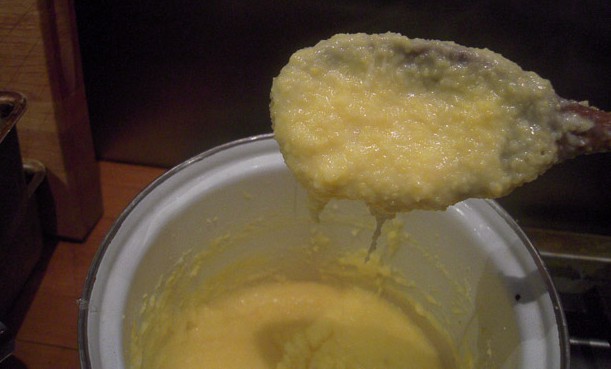
The key to creamy polenta is 5 times the amount of water to polenta, and then let it simmer at the back of the stove for an hour or more. You may need to add more water occasionally, as the grains soak it up and become super plump and delicious. Even “quick cooking” polenta benefits from this.
5. Air
Okay, I know this one seems silly, but think of what wine tasters do. They get a nice big glass – full of AIR – and they put a tiny bit of wine in the bottom. Then they swirl the wine around and around in the glass. When they finally take a sip, they swish the wine around in their mouths and breathe in air through their teeth to get more flavour. These are people who taste for a living, so you have to trust that they know what they’re doing.
When dealing with food, this translates in a few ways. The first is that I try to make sure my food has loft; rather than patting it all down on the serving platter, I like the pieces of a dish to settle down at their own discretion, and that usually means little air gaps in between. Does this help? I like to think so. It certainly helps if these air gaps make it to your plate, so when you take a bite of food, you have a little bit of air built in – a breathing space, if you will – for tasting the different elements on your tongue. Alternately, just taking smaller bites (and chewing more per bite) gets the air in and around your food.
Another obvious way that air helps is when making a soufflé, or whipped cream, or a cake. A good example would be Swiss buttercream, which is my favourite frosting, being light and rich at the same time. Its gloriousness is achieved by whisking egg whites and sugar, and then whipping butter into the mix. The result, having all that air whipped in, is so much better than if you just mixed together sugar, egg white and butter in a bowl.
But that last bit’s not a tip, that’s COOKING I can hear you exclaim, exasperated. Why yes, I believe it is. Case closed. Air wins.
6. Parsley (or other herbs)
My love for flat-leaf parsley knows no bounds. A liberal dose enlivens any dish, bringing an earthy and fresh quality to meat, stew, salad, sauces, pasta… The only place I have yet to use flat-leaf parsley is in sweet things, but give me time, I’ll think of something.
To be honest, although herbs are a huge boon for flavour, I don’t think they can replace certain elements. I’ve heard so many times that if your food is bland, don’t reach for the salt, just add herbs. I disagree. Food needs to be seasoned properly to get the most out of it, but herbs can add a quality that you didn’t even know was lacking.
Fresh herbs are almost always my choice, but some dried herbs have their place in my cupboard. Dill weed, wild thyme, and Mexican oregano are three that I love. For fresh herbs, I most often use parsley, followed closely by bay (we have a tree outside, which makes this extremely convenient), and rosemary. I use others, of course, but these are my standards.
7. TIme
Like Air, time is an intangible with cooking but so necessary. There are many ways to use time to your advantage. One that I find indispensable is to put some time between me and the dish I am tasting. Sometimes, I taste a soup so much while making it that I have no idea anymore what it needs. I find that if I leave it alone (with the heat off, if everything else about it is at the right point), attend to something else, and then come back 10 minutes later, I am able to freshly assess what it needs.
Sometimes, too, a dish is better if left overnight. Stews are an obvious example, but a cabbage salad that benefits from a bit of wilt might be even more to your liking with a more time added between the making and the eating.
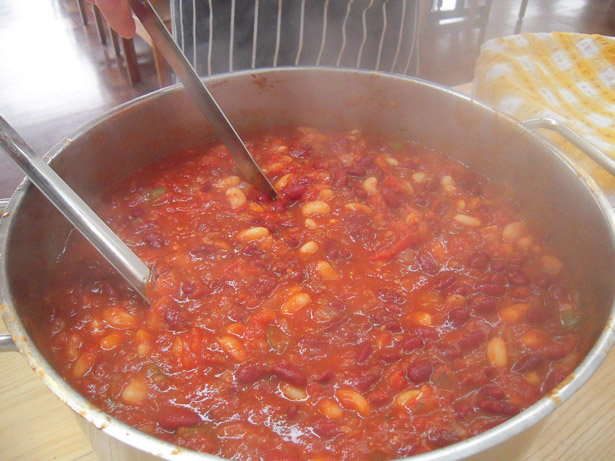
Chili is one of those soups/stews that benefit from sitting around for a while – given time, the beans start to soak up the flavours around them, making a taste that is more complex than the beans or the broth by themselves.
8. More heat
Every cooking method yields its own results, and one result I like is caramelisation – you know, the crispy bits of roasted potatoes. To get this, you need high oven heat.
Bread, too, needs a good heat to spring and then set and start to brown – otherwise it can rise too much and result in a loaf with an unsatisfactory crumb and a pale, chewy exterior.
To get a good steak cooked rare, you need a high heat to sear the outside and leave the inside pink and juicy.
Reducing a cream sauce or boiling off wine are other processes where high heat comes in handy.
Cooking jam to a set point requires a high boil, to get the sugar to set as quickly as possible, before you lose the colour of the fruit.
I think you get my drift.

Perfectly cooked raisin bran loaves. The heat was at 170C in a fan oven, so about 190-200C in a conventional oven. Thats a lot of BTUs!
9. Less heat
I know, I know, this is contradictory to Number 8, but that’s just the way of life. If the heat is too high, you get meat that is seared on the outside and raw in the middle – great if you want it that way (see #8), but if you prefer medium-rare to well-done, use a lower heat so you aren’t gnawing through bits of charcoal to get to the centre of your steak.
Less heat is the only way to make meringues properly – my oven is practically off for them. In fact, the last bit of almost every meringue recipe says to leave them in the turned-off oven overnight to dry them out. Now that is as little heat as you can possibly use to cook!
Less heat is the way to sauté a mirepoix – you don’t want to burn the vegetables before you extract all the flavour out of them, otherwise your finished dish will be bitter and bland. (But if it’s not cooking well, and just kind of limply sitting in the oil or butter, add more heat!)
In general, think about the end result – if you want high colour (i.e. caramelisation) and the integrity of the original ingredient intact, use higher heat. If you want a melding of the inside and the outside – in other words, a uniform cooking – use lower heat.
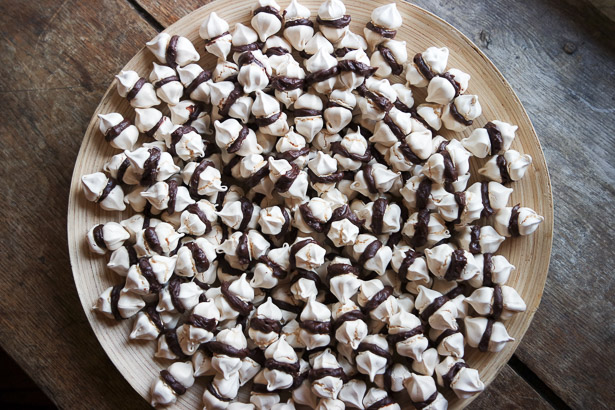
Meringues need a delicate touch in the oven. Some of these were baked at too high a heat, and you can see the split in the surface. Still delicious, but the texture would have been better if the oven had been 10 or so degrees cooler.
10. A good knife
The best advice I can give to any aspiring cook is this: get the best knife you can afford, made from strong steel, and learn how to use it and maintain it. A sharp knife (and good knife skills) can take the place of many kitchen gadgets, with far less washing up. And not only does a good sharp knife make prep work enjoyable, it is also safer to use, being less likely to slide off a hard vegetable and onto your finger.
It has been noted that a sharp knife is more likely to stave off tears when you are chopping onions, as the edge doesn’t press on the onion juices but simply glides through them. I’m not sure if I agree with this or not, but I do think it makes chopping onions into teeny tiny pieces much easier.
And that’s the top tip about a good knife: the size of your vegetables, at any stage of cooking, directly correlates to what they will taste like cooked. A mirepoix is a small dice specifically so all the flavour can be extracted from the vegetables at the start, leading to a more flavourful soup or sauce. Pieces of garlic, a bit overpowering in a sauce, can be minced (or puréed) to perfection with a good sharp knife, and then they blend right in, with no unpleasant distractions. And tomatoes! That is where a sharp knife will become your best friend. Trust me. A beautiful, thinly sliced tomato (as opposed to a mangled, crushed tomato) is easily and safely achieved with a decent sharp knife, and that makes a caprese salad, for example, look and taste so much better.
Back at our house, The Poppet has not yet mastered the guitar, but she still plucks away at it in her own make-shift jam sessions. For now, she’s pretty happy just pootling along at her own pace, and I think that’s probably the best that can be said of any of us. But if she wants any more direction, perhaps The Author will give her some top tips of his own.
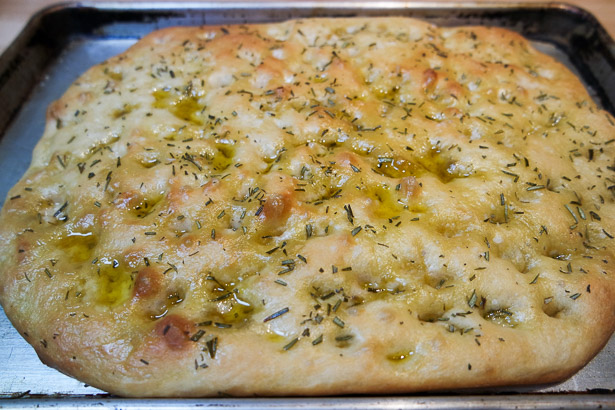

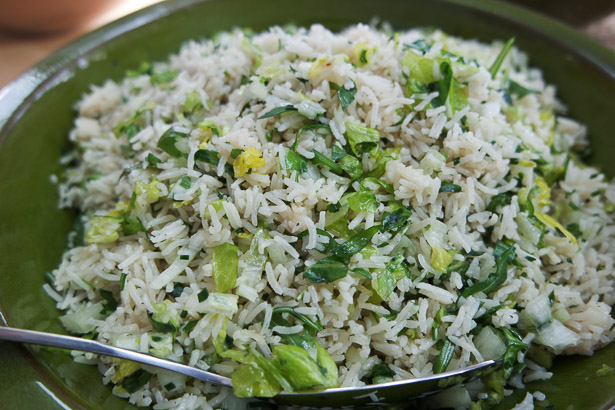
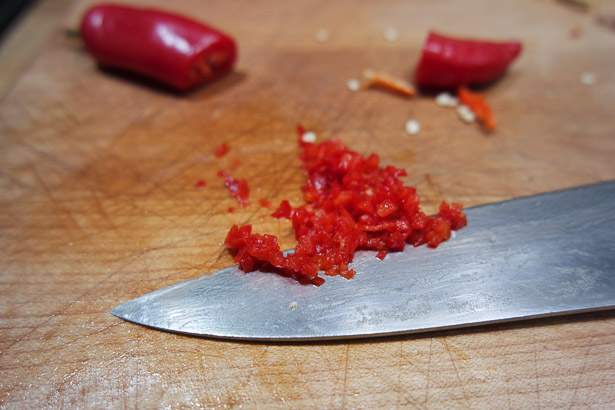
Tara,
I loved all your suggestions and found them very helpful. I would add another herb that is one of my staples as an Italian who loves to cook – Fresh Basil. We grow it in pots on our deck and it is available most of the summer here in Vermont. We also dry some for the colder months.
Thanks again for all your great advice and my best to Pip and the rest of the family.
Warm Regards,
Louis Giancola
LikeLiked by 1 person
Hi Louis,
Yes, of course basil!! xoxo
LikeLiked by 1 person
Masterful! I think this is the introduction to your cookbook, Tara.
LikeLiked by 2 people
Tara, I love this list–simple enough for even the most novice of cooks. I instinctively cook this way (although enough salt is a rather new necessity for my taste buds), but reading your list helps me know the reasons for what I “know.” Thanks you!
LikeLike
Thank YOU!
LikeLiked by 1 person
You are most welcome!
LikeLike
Pingback: Creamy Mushroom Soup (or, a diversion from the misery of parenthood) | Little Home Kitchen
Pingback: Sri Lankan Potato Soup | Little Home Kitchen
Pingback: Cheesy Polenta Chips with Tomato Chutney (or, OMG) | Little Home Kitchen